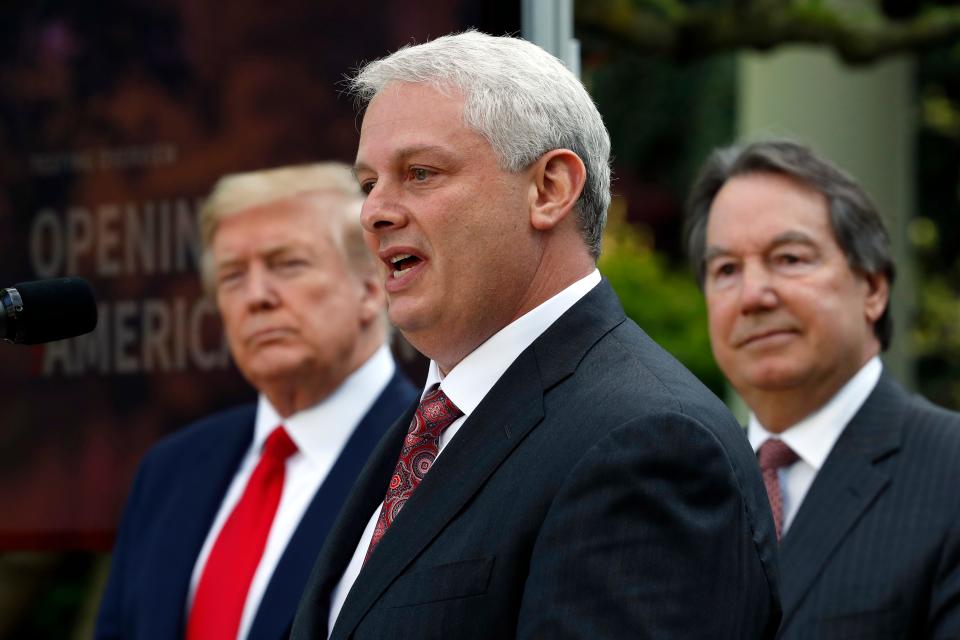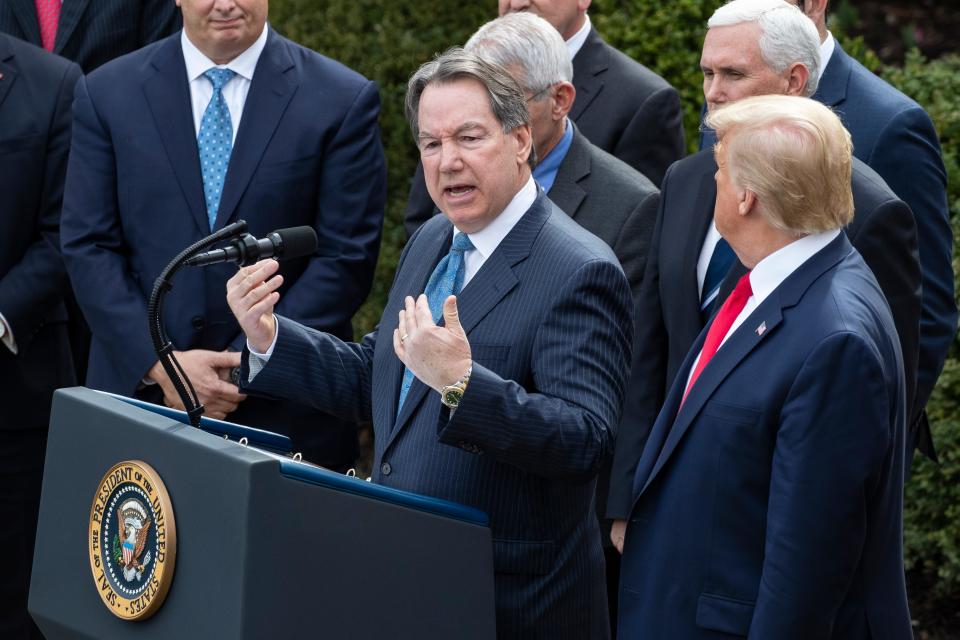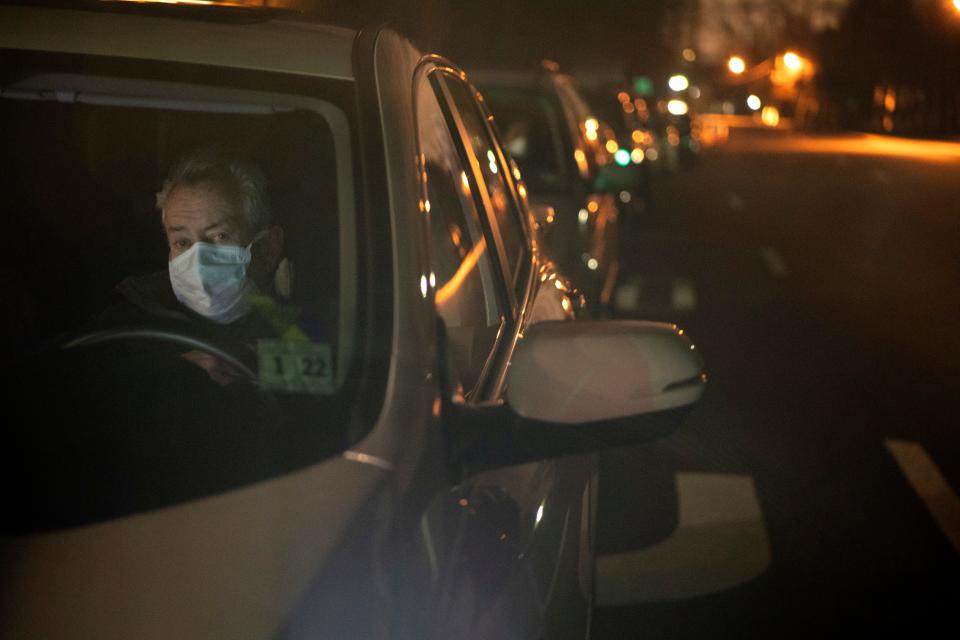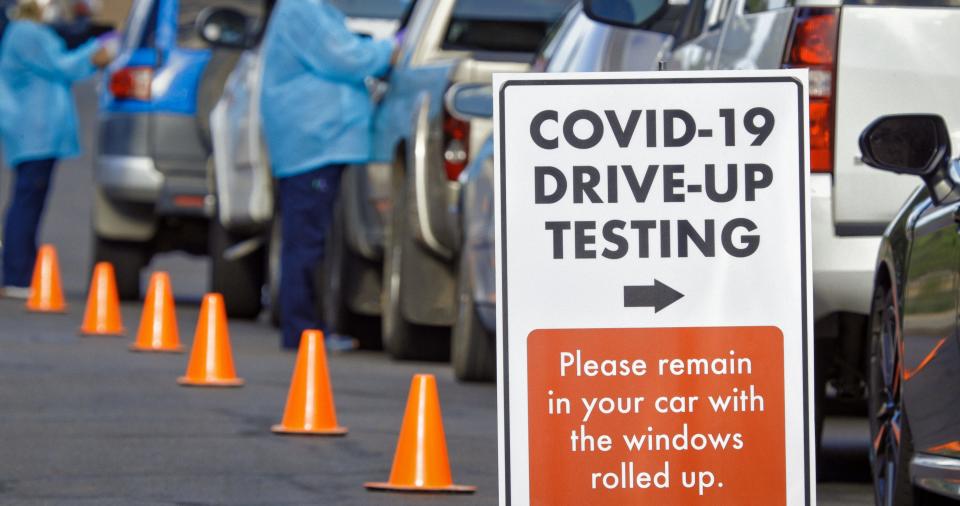COVID-19 chaos: Presidential efforts fail as doctors are left trapped
- Oops!Something went wrong.Please try again later.
- Oops!Something went wrong.Please try again later.
Scott Gottlieb was standing inside the White House early on the morning of Friday, March 13, 2020, when an aide to President Donald Trump handed him a FedEx package. Open it, the aide said, giving a mischievous smile. Inside, Gottlieb found two plastic vials filled with enzymes. Gottlieb, a trained medical doctor, knew what the vials were for: to preserve mucus from a nasal swab until the sample could be tested in a laboratory.
“These two test kits, I was told, were for the president,” Gottlieb wrote in his book, "Uncontrolled Spread."
After Gottlieb briefed the president in the Oval Office that day, Trump gave a press conference in the Rose Garden, where he declared COVID-19 a national emergency. He announced a partnership with Quest Diagnostics, Labcorp and test machine manufacturers, but didn’t mention any details. Quest Diagnostics CEO Steve Rusckowski said the company would deliver new, high-throughput genetic testing machines into its laboratories that weekend.

A few minutes later, Trump appeared to question the need to increase testing at all.
“Again, we don’t want everybody taking this test; it’s totally unnecessary,” he said. “And this will pass. This will pass through, and we’re going to be even stronger for it.”
Looking back on that stressful day, Gottlieb, a former commissioner of the Food and Drug Administration, now thinks it was already too late.
“This was a policy lapse,” he said during an interview with NorthJersey.com and The Record. “Someone needed to call the commercial manufacturers in January [2020] to say we need you to get a high-throughput platform up and running.”
The Rose Garden press conference established three patterns of federal response to the pandemic: Presidents of both parties would claim to take the nation’s genetic testing emergency seriously. But they would fail to create a national plan for it, and instead would abdicate their responsibility to Labcorp and Quest.
“We don’t have a regional integration system” for COVID-19 tests and data, said David Perlin of Hackensack Meridian Health. “We certainly don’t have a national integration system. If we did, you’d know in a flash what our COVID-19 status was. And we don’t know that.”
Logistics collapse
Early in the pandemic, Quest and Labcorp’s vast logistics networks suffered. There were several reasons for this, said Mara Aspinall, an adviser to the Rockefeller Foundation. In many states, the same emergency orders that closed bars and sporting events also applied to Quest and Labcorp sample sites. In areas without shutdown orders, sites remained open but couldn’t take nasal swabs, because they had the staff and equipment they needed to draw blood, not mucus.
Moreover, the giants’ regular customers simply disappeared, said Robert Michel, editor-in-chief of The Dark Report, a trade publication focused on the diagnostic testing industry. Non-emergency surgeries were canceled, so hospitals stopped ordering tests. Besides, people who can’t breathe due to COVID-19 don’t call Labcorp or Quest, Michel said. They call their doctor, or go to urgent care or the emergency room to get lab tests.
By the second week of April 2020, total testing volumes at some laboratories dropped by nearly 90% from pre-pandemic levels, according to data compiled by The Dark Report. This created a crisis for Quest and Labcorp: too many COVID samples to be run by their available staff and machines; not enough regular, non-COVID samples to pay the bills.
Both companies faced financial crises. Testing volume at Quest labs dropped 40% in March 2020. The company furloughed 4,000 workers. Managers, board members and CEO Steve Rusckowski all took temporary pay cuts. Labcorp’s volume dropped 50%, so the company froze hiring and laid off temporary workers. Altogether, the diagnostics industry lost $2 billion in revenue in early 2020, representing a 14% drop in a single quarter, according to the Federal Reserve Bank of St. Louis.
“If you look at the disadvantages of centralization, you have a lot of volume going though those few labs,” Aspinall said. “If one system goes down, all of a sudden you have a million customers with no results that have to be tested somewhere else. No system is set up for a million new customers in two weeks.”

At smaller labs around the country, excess testing machines and supplies sat unused during the early weeks of the pandemic, said Michel and Mark Birenbaum, executive director of the National Independent Laboratory Association. This was partly because smaller labs had been purposefully excluded from narrow networks.
“The big labs couldn’t handle the testing,” Birenbaum said, “but early on our labs weren’t getting the specimens, so they couldn’t pitch in to help.”
Quest, Labcorp and the rest of the industry bounced back to post record revenues in 2020. But many industry insiders found it sobering to watch the giants stumble.
“This is a situation where having just two big labs controlling such a large proportion of the industry can create problems in emergency situations," Birenbaum said.
Pop-ups fall down
As the national logistics networks stalled, hospitals and governments were forced to improvise. A few minutes after midnight on a cold morning in March 2020, Kim Gomez stopped her car along a two-lane highway in Paramus, New Jersey. For three days, her fever held steady at 104 degrees. On the fourth day, she decided she needed a COVID-19 test.
“I feel so bad. Like somebody is squeezing my head,” said Gomez, who was third in line for a drive-thru testing site in a community college parking lot. “I went to an emergency room. They told me to come here. There’s nowhere else to go.”
By 5 a.m., the line of cars was half a mile long. Processing so many patients took hours, even though each test required just a few seconds. Such delays repeated across the country, as health workers labored to enter patients’ health information into the jury-rigged computer system of each pop-up site.
In normal times, lines at Labcorp and Quest are short. That’s because both companies use online scheduling systems to match patient loads with available staff and supplies. The testing giants also get all the medical data they need straight from patients’ doctors.
But pop-up sites sprang up so quickly, their data systems were built for light duty. Many ran off a single laptop.
“The major laboratories, Labcorp and Quest, they’re tremendously automated. They have strong data systems, but even they were caught off guard,” Aspinall said. “It sounds like not a big deal. But when you get a million samples and you’re only set up for five thousand, that’s a big deal."
Improvised computer and logistics systems also couldn’t handle the volume or sophistication of modern medical records.
“The major labs have quality safeguards built in, including barcodes that are shared with their existing distribution channels and courier networks,” Aspinall said. “All of a sudden you had counties, cities, pharmacies, none of which had any history of taking very intricate samples, in huge volumes, and labeling them. And they were sending these samples to labs, many of which they had never worked with before.”

After a patient’s test is performed by Quest and Labcorp, the result is communicated to all the patient’s doctors, and to public health agencies. At pop-up sites, that didn’t happen, said Janet Hamilton, executive director of the Council of State and Territorial Epidemiologists. In 90% of cases reported to public health agencies, contact tracers didn’t receive the information they needed to begin their investigations, according to a survey by Hamilton’s group.
The result was that pop-up sites helped keep individuals healthy. But to protect public health — perhaps the most important reason to test for COVID-19 in the first place — they contributed little of value.
“Many of the labs that emerged into this space had never reported to public health before. They didn’t know how,” Hamilton said. “Also, when they did know, it wasn’t as though public health was a priority.”
Doctors in a trap
Doctors and hospitals faced the opposite problem. Their computers were too heavy and hardwired to change. Even as turnaround times at Quest and Labcorp stretched out to 12 or 15 days, doctors continued sending them new test orders.
“If that result takes a week to get back, what good is that?” said Jennifer Nuzzo, an epidemiologist and public health expert at Brown University.
This sounds illogical, until one considers the alternative.
To go around Quest and Labcorp, each doctor would need to negotiate a contract with a laboratory with excess COVID-19 testing capacity, as well as data and logistics systems that comply with federal privacy law.

Since the new lab wouldn’t appear as an option in the doctor’s computer template, the doctor would write out every test order by hand. The paper form would be affixed to the plastic sample tube, either by a rubber band or inside a plastic baggie, said Michelle Meigs, director of the informatics program at the Association of Public Health Laboratories, which advocates for public testing labs. Next, the doctor would need to find and hire a HIPAA-compliant courier service to drive the sample to the lab, and drive the results back.
Even in normal times, no doctor has time for that.
“Providers are super busy,” said Jeffrey Klausner, a public health expert at the University of Southern California. “If they want to send it to another lab that’s not already welded into the system, they have to do what’s called a ‘send-out test.’ It’s a manual thing. The whole system freezes. So the provider is strongly biased not to send to a new lab, even though the existing lab may have a seven- to 14-day backlog.”
In some situations, hardwired medical records systems add unnecessary burdens to labs that are already inundated.
Thomas Durant, an informatics researcher at Yale School of Medicine, describes a common experience in which his lab at Yale sees a patient whose medical record indicates he’s received two recent COVID-19 tests. Perhaps both tests were performed by Yale. Or maybe one test happened at Yale, but the other was run by an Abbott machine inside a CVS pharmacy. That’s information doctors at Yale would like to know, Durant said, because research suggests that tests by Abbott machines may be less sensitive.
Data silos operated by hospitals, laboratories and doctors often don’t record the type of testing platform used, however. If they do, Durant said, that data often drops out as the record passes from one silo to the next.
When doctors don’t know the answer to a question, they order another test, Durant said. This complex problem is actually one of the simplest ways in which dysfunctional silos slow testing down, and limit total test supply.
“We can punch a hole in the wall, and we can peek through,” Durant said, describing how the software stack at Yale interacts with stacks operated by other health institutions. “But I don’t know what happens behind the scenes at CVS. If we don’t have access to the data, then we end up duplicating work.”
This article originally appeared on USA TODAY: Donald Trump's COVID response failed, doctors left trapped
